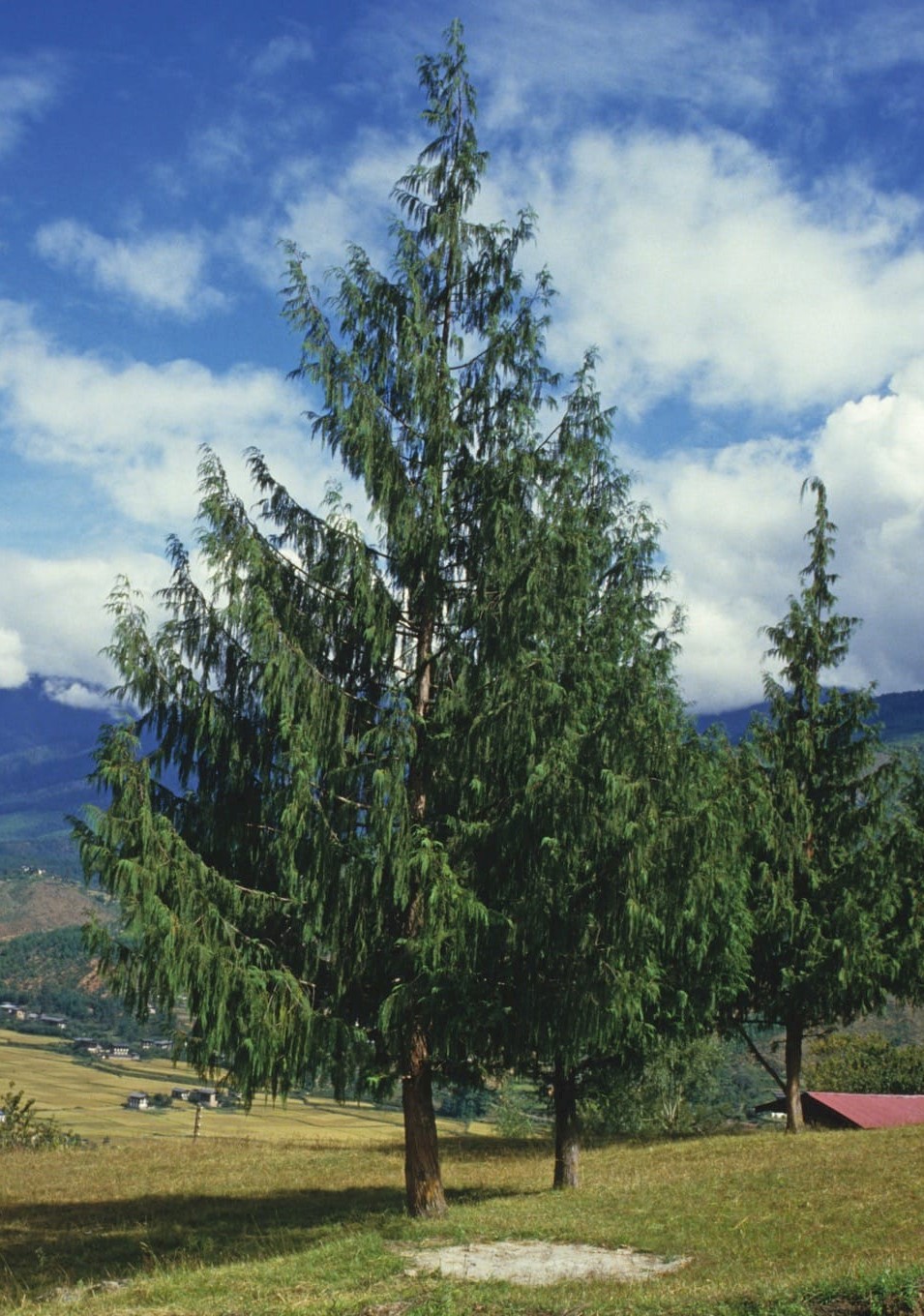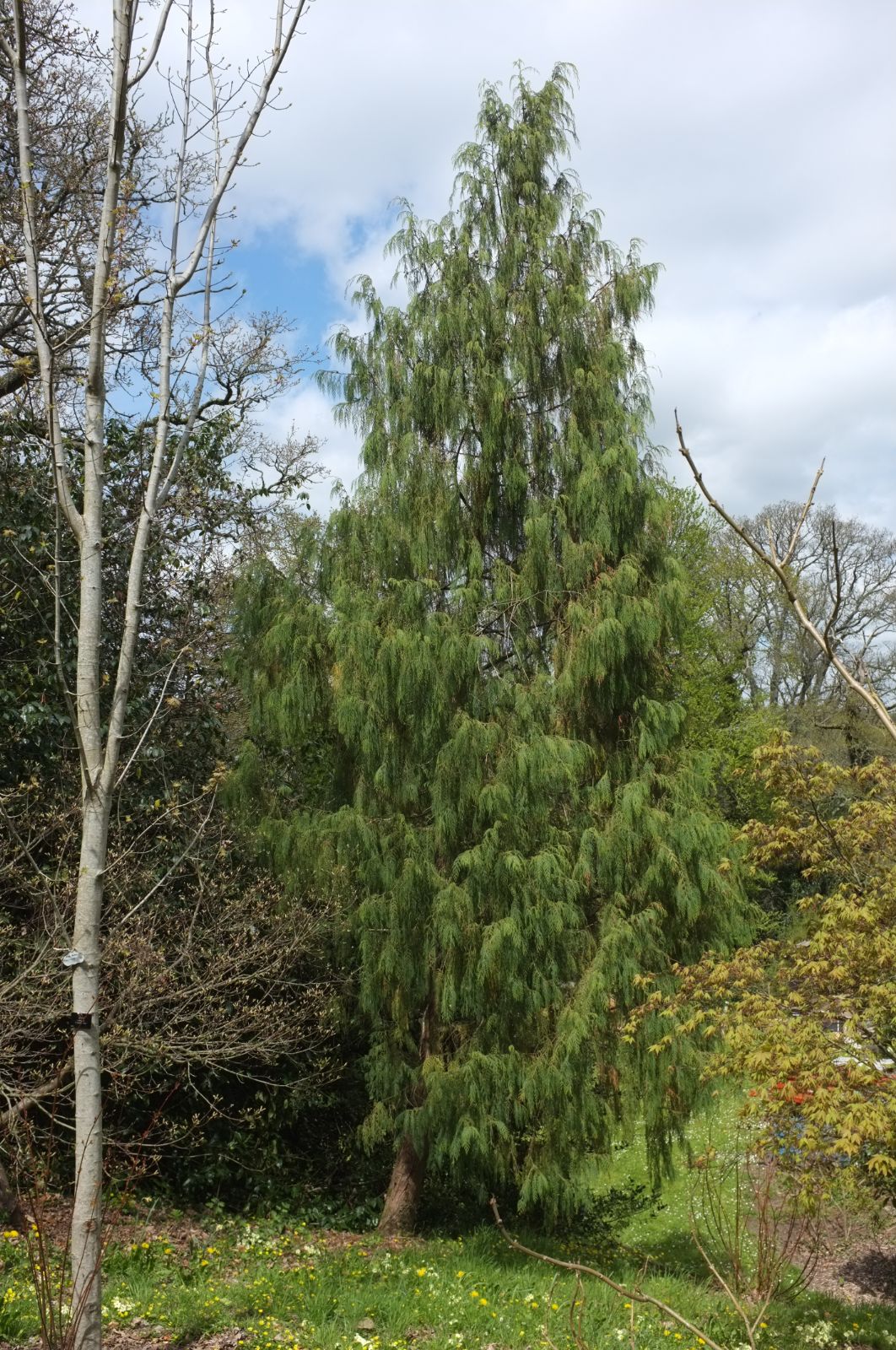Cupressus himalaica
Credits
Article from New Trees by John Grimshaw & Ross Bayton
Recommended citation
'Cupressus himalaica' from the website Trees and Shrubs Online (treesandshrubsonline.
Genus
Common Names
- Bhutan Cypress
Synonyms
- C. cashmeriana auctt. non Royle ex Carrière
- C. corneyana auctt. non Knight & Perry ex Carrière
Other taxa in genus
- Cupressus arizonica
- Cupressus austrotibetica
- Cupressus bakeri
- Cupressus cashmeriana
- Cupressus chengiana
- Cupressus corneyana
- Cupressus duclouxiana
- Cupressus dupreziana
- Cupressus forbesii
- Cupressus funebris
- Cupressus gigantea
- Cupressus goveniana
- Cupressus lusitanica
- Cupressus macnabiana
- Cupressus macrocarpa
- Cupressus sargentii
- Cupressus sempervirens
- Cupressus torulosa
Tree 40–60(–80) m, 2 m dbh. Bark brown, with shallow vertical fissures. Crown conical to columnar, with variably pendulous branchlets. Branchlets variably drooping, dark green; foliage in partially flattened sprays with facial and lateral leaves distinct. Juvenile leaves needle-like, 3–7 mm, in opposite pairs or whorls of three or four; mature leaves dark green, 1–3 × 1–2 mm, acute, on strong whip shoots, subacicular, with decurrent bases up to 8–10 mm long; leaf resin gland sunken, 1 mm long, forming a conspicuous longitudinal groove on facial leaves, present but less obvious on lateral leaves. Male strobili cylindrical, 4–8 × 1.5 mm, shedding pollen in autumn. Female cones produced singly or in clusters of up to 10 or more, dark green to brown, maturing dark blackish brown about 24 months after pollination, variably opening at maturity or remaining closed for a year or more, ovoid-globose, 1–2.2 × 1–1.8 cm, with 8–12 scales in opposite decussate pairs. Seed scales five- to six-sided, up to 1 cm wide, smooth, drying to become coarsely wrinkled after opening; umbo 1 mm long, 2–3 mm broad, dark green to brown. Seeds red-brown, 3–4 mm long, with two narrow ineffective seed wings on sides; 5–20 seeds per cone scale. Long 1980, Rushforth 1987a (as C. corneyana); Miehe & Miehe 1998. Distribution BHUTAN: Pho Chu valley, Punakha Tsang Chu valley. Habitat Mountain slopes on limestone between 2300 and 3000 m asl. USDA Hardiness Zone 7–8. Conservation status Not evaluated under this name (IUCN), but probably vulnerable in the wild, as for C. cashmeriana (IUCN 2007–2008). Illustration Rushforth 1987a (as C. corneyana), Farjon 1994; NT299.
The taxon described here is a distinctive, large tree with variably pendulous shoots that has suffered under a weight of muddled nomenclature. It was recognised as distinct by Long (1980), who recorded it as a wild species in Bhutan, but also as a cultivated plant there and elsewhere in the eastern Himalaya, applying the name C. corneyana Knight & Perry ex Carrière (as did Rushforth 1987a).
Cupressus corneyana was originally published by Carrière in 1855, validating the Chelsea nurserymen Knight and Perry’s epithet, but this name is of uncertain application as the description is vague and there is no type specimen (Clarke 1988: S203; Farjon 1994). Knight and Perry did not know where the original material had come from but assumed northern China or Japan; in a splendid leap of imagination, they named it after a merchant in China who occasionally sent them seed, one Mr Corney (Elwes & Henry 1910). Cupressus corneyana Gordon, published in 1862, probably represents C. torulosa (Farjon 1994). Bean (1976a: B808) and Krüssmann (1985b: K111) attribute the name to a cultivar of C. torulosa (Bean as var. corneyana, Krüssmann as ‘Corneyana’), with pendulous branches and irregularly arranged shoots. Silba (1983), however, believed that older cultivated material labelled C. corneyana represents the Mexican C. lusitanica. The name should be abandoned, but persists in gardens and in the literature in reference to eastern Himalayan weeping cypresses, as well as in the miscellany mentioned above.
According to Farjon (2001, 2005c) the eastern Himalayan weeping cypresses, now widely cultivated in both Europe and North America, should be recognised as forming part of the variation of Cupressus cashmeriana Royle ex Carrière. Although this species was covered by Bean (1976a), his description is of the long-familiar selection with beautiful, long-weeping glaucous shoots often referred to as the Kashmir Cypress. The eastern Himalayan plants, which are cultivated under a number of often rather randomly applied names, seem quite different to this well-known but tender plant (although C. himalaica var. darjeelingensis Silba appears to refer to it). There are clear similarities with C. cashmeriana, but in view of morphological differences – principally the dark green, often less pendulous foliage, conspicuously glandular facial leaves (glands inconspicuous in C. cashmeriana) and smaller cones (1–2.2 1–1.8 cm, vs. 1–3 1–2.5 cm in C. cashmeriana) – and its clearly circumscribed natural distribution (the Kashmir Cypress is of unknown wild origin), we cautiously recognise the Bhutan Cypress as a distinct entity, under Silba’s name C. himalaica. In the wild it seems to be restricted to the limestone areas of the Pho Chu valley, around Norbding, and in the Punakha Tsang Chu valley (Long 1980, Miehe & Miehe 1998; K. Rushforth, pers. comm. 2008). Silba has also described another taxon, C. assamica Silba, with similar characters but from the West Kameng district of Arunachal Pradesh, India; this has flatter sprays and also occurs naturally on limestone on the northern slopes of Mount Piri (K. Rushforth, pers. comm. 2008).
Rushforth (1987a) notes that mature trees of the Bhutan Cypress can reach 40 m, 2 m dbh, but trees up to 80 m – and possibly even taller – have been reported (Farjon 2005c), and must be a fine sight. The first verified introduction to Britain of Bhutanese material was Grierson & Long 234, from trees planted at the Dukye Dzong monastery northwest of Paro, in 1975 (Long 1980; illustrated in Rushforth 1987a); consequently only young plants a few metres tall are currently known in cultivation. Trees from Grierson & Long 234 have foliage which is only slightly pendulous. There is a particularly attractive specimen, worthy of propagation, at Quarryhill, under the name C. himalaica. Grown from a Bruce Bartholomew collection (BB 113) made in Bhutan, it was planted out in 1992 and by 2004 was about 7 m tall, with a very elegant weeping habit. Its growth has been steady rather than spectacular, as it is on a rather poor dry bank, but another specimen at Quarryhill, obtained from Heronswood Nursery as C. torulosa ‘Cashmeriana’ (now re-labelled C. himalaica var. darjeelingensis), had grown 3–4 m by 2004, since planting in 2001. The taxon is evidently tolerant of a wide range of conditions, as demonstrated by a beautifully columnar 7 m specimen in the JC Raulston Arboretum, planted in 1996 (labelled C. darjeelingensis). As C. corneyana, shapely young trees have been seen growing well at Glenwhan Garden in Dumfries & Galloway, at Bedgebury Pinetum in Kent, and at Exeter University and RHS Rosemoor in Devon.
Seed distributed by John Silba as C. assamica in the 1980s was collected from street trees growing in the town of Bomdila near Assam, Arunachal Pradesh, which included introduced Mexican taxa. The resultant seedlings represent a hybrid swarm and should be discarded (K. Rushforth, pers. comm. 2008), and any tree so labelled should be viewed with great suspicion. As a wild plant C. assamica is restricted to limestone slopes in northern Arunachal Pradesh (see above). Very young seedlings from this area are now in cultivation (K. Rushforth, pers. comm. 2008), but will require further study as they mature.


